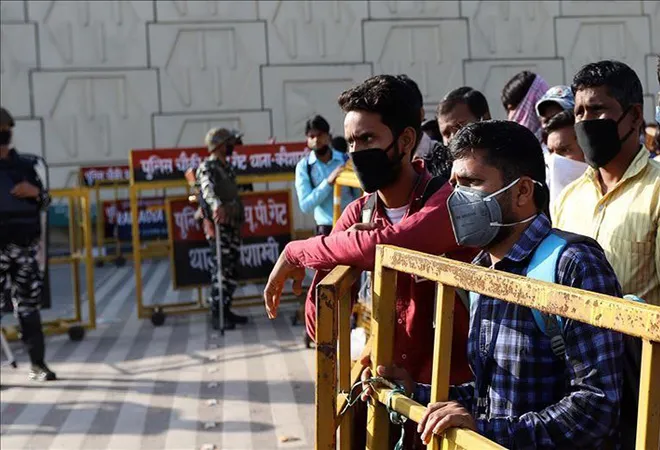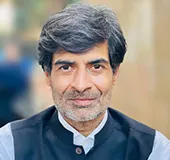
Experts at India’s Ministry of Health and Family Welfare published a paper on 9 April, 2020, looking at 41 sentinel sites across the country. It revealed that of the 5,911 severe acute respiratory illness (SARI) patients tested since 15 February, 1.8% have tested positive for Covid19. Of those who had tested positive, 39.2% did not report international travel or any history of contact with a known patient—clearly indicating that at least parts of India are likely in the stage of community transmission. By itself, this is neither unusual nor surprising—it is indeed the nature of pandemics to take root in communities over time.
A total of 179,374 samples from 164,773 individuals have been tested as of 11 April, 2020. Just around 7,703 individuals have been confirmed Covid19 positive. India is testing just over 17,000 samples per day, which is inadequate given the vastness of the country and the current spread covering almost half the districts. This means that the true scale of spread remains unknown and most areas remain potential breakout zones. The spurts that we are witnessing in cities like Mumbai, Delhi, Jaipur, Indore, and Ahmedabad are cause for deep concern.
India is testing just over 17,000 samples per day, which is inadequate given the vastness of the country and the current spread covering almost half the districts.
Despite efforts over the past few weeks to give it a boost, India’s healthcare delivery capacity remains limited. According to the Government, an order for 49,000 ventilators has been placed in view of the low numbers that exist within the system, but it is unclear by when they will arrive and be distributed among the special centres created for Covid19 patients. The Government has acknowledged the need for “rapidly ramping up” the number of Corona-testing facilities, Personal Protective Equipment (PPEs), Isolation Beds, ICU beds, ventilators, and other essential equipment. This only serves to highlight the fact that the current levels of healthcare facilities will not stand a chance of coping with a sudden and huge surge. Hence, a national lockdown was, and remains, the only option since any widespread community breakout will overwhelm medical infrastructure.
A national lockdown was, and remains, the only option since any widespread community breakout will overwhelm medical infrastructure.
If we go by what has been officially stated, more than half of India’s districts are yet to record a single case of Covid19. But the virus may have made its way to many of these districts. Whether or not this is true will only be known through increased testing, which has not happened and is something that needs to be rectified with alacrity.
India has no doubt responded strongly and decisively to the crisis by opting for a countrywide lockdown. According to the Oxford Covid19 Government Response Tracker (OxCGRT) database’s Stringency Index, on 25 March, India was the sixth country to opt for a complete lockdown and achieve a stringency index score of 100.
Yet, the fact remains that the lockdown is a blunt instrument. A country like India cannot afford to indefinitely extend it across regions when a clear assessment of the risk of community spread is impossible for lack of information.
The fact remains that the lockdown is a blunt instrument. A country like India cannot afford to indefinitely extend it across regions when a clear assessment of the risk of community spread is impossible for lack of information.
The lockdown, as we have it now, has virtually brought the national economy to a grinding halt. This hurts the informal workforce, micro businesses, and unorganised labour the most and is bound to have long-lasting implications. The use of a nation-wide lockdown, instead of a fine-grained approach, was a forced hand because of the impossibility of conducting local level assessments of the spread. The cost of not testing smartly or widely enough—whatever the reason—is unfortunately being borne disproportionately by daily wagers and vulnerable groups.
We can only hope that the experts the Government is consulting have briefed the political leadership of the lessons learnt—nationally and globally—over the past months. And that in the next week or two, we will not be blinded by lack of information or intent, or be limited by tentativeness of action. One must make it clear that full marks need to be given for the stringent 21-day lockdown: It was the need of the hour.
However, as of now we have failed to capitalise on the time advantage the lockdown has given us. We need to think on our feet, tap into every resource possible, and formulate an exit strategy rather than make the poor pay for an overburdened system’s lack of agility. We also need to prevent value destruction on account of unimaginative policy.
This is the moment to embrace talent from outside the confines of Government and infuse economic policy with ideas to reignite the Indian economy and tell the world that the India Story is far from over. Prime Minister Narendra Modi must seize the moment.
Various assessments of the post-pandemic world suggest that there is a real threat of gains in poverty reduction being reversed on account of Covid19’s impact on the global economy. India would not remain untouched if this were to happen. We need to act now to mitigate the impact of the blow even if we cannot avoid it entirely.
Various assessments of the post-pandemic world suggest that there is a real threat of gains in poverty reduction being reversed on account of Covid19’s impact on the global economy. India would not remain untouched if this were to happen.
India is an outlier in terms of the scale and extent of the lockdown. Over the next fortnight, we should aggressively try and map the spread of the virus using methods such as countrywide sample testing or pooled testing. It is encouraging that States like Maharashtra are currently considering such strategies. We need to come up with a blueprint for a staggered approach to get us out of the unsustainable country-level total lockdown.
India cannot be a country in suspended animation waiting for a miracle to happen. For, a miracle won’t happen, no matter how hard we pray for it. That is not how killer viruses run their course. That is definitely not how the Covid19 pandemic is playing out globally. A pragmatic and scientific approach is the only way out of this seemingly impossible maze; that’s how you win a game of Chinese Checkers.
Three stark comparisons have emerged in the past two weeks. Statistically, despite its limited health infrastructure, India has done better than most others—especially advanced nations in Europe and America with fabled health services—in terms of infections, hospital admissions, ICU crowding, and fatalities.
Second, India has witnessed strong cooperation between the Union Government and State Governments (health is a State List subject, a fact often forgotten or unknown to commentators) and there has been bipartisan support for the measures initiated by the Prime Minister. In other democracies, bitter partisan politics over Covid19 have been on display.
Third, India is the only large economy where a lockdown has been accompanied by the near shutting of the national economy, resulting in an unprecedented disruption in jobs, productivity, and revenue.
If prevention is the primary tool India has adopted, then a blanket lockdown cannot be the only instrument we use. Tech and data-driven mapping of senior citizens and those people suffering from non-communicable diseases (NCDs) has to be extensively conducted. Everything from Aadhar and municipal data to digitised hospital records need to be scanned to figure out exactly who must stay home—and will need to be assisted in this regard—and who can be permitted to return to a less-restrictive, soft-lockdown work environment. Community health workers must be deployed for aggressive mapping of villages and urban settlements for the invisible elderly and chronically ill - finding those who do not exist in any current electronic health record is key. Of course, this has to be a ‘privacy sensitive’ exercise.
We have seen skillful deployment of the lockdown by all, but this policy hammer has not been accompanied by a sharp economic respite. Experts from India and abroad seem to converge on the idea that spending is necessary and that money deployed must reach its intended goal within a specified timeframe. These goals must include lifeline protections, support for supply chains and demand stimulation, and wealth protection. While the central government must focus on the macro instruments and agencies, its energy must now also be directed towards protecting capital. The state governments must partner with specialised institutions to respond to local challenges that are contextual and individual and, in such instances, community programmes must be implemented.
We have seen skillful deployment of the lockdown by all, but this policy hammer has not been accompanied by a sharp economic respite. Experts from India and abroad seem to converge on the idea that spending is necessary and that money deployed must reach its intended goal within a specified timeframe.
It could be argued, and correctly so, that human lives matter more than the economy which can be rebuilt. While this sentiment may sustain popular support for strong measures to control and rollback the pandemic, it will not obviate the need to address serious concerns linked to the economy which sustains livelihoods and, hence, life itself.
This is why a staggered exit from the lockdown, accompanied by stepped-up testing to cover every district, is necessary. A containment policy has been drafted and is already being implemented by several states after identifying ‘hot spots’. There is across-the-board agreement on what must not be done—namely, resumption of inter-State travel by plane, train, or bus.
What we need now is an agreement on what can be done. This list must include immediate resumption of agricultural activity (harvesting cannot wait for too long); restarting of certain micro, medium, and small enterprises so that the impact on jobs and income disruption is minimal; and resumption of basic economic activities like reviving stalled supply lines and retail services to ensure the looming crisis of essential goods is avoided while ‘social distancing’ remains in place. In the next stage, resumption of other activities like construction and reopening of some commercial and trading entities can be considered. Industries must then begin to operate under a special safety protocol which will ensure protection.
If the challenge of shutting down India was huge, the challenge of reopening India will be bigger. But India cannot, and must not, remain shut down for longer than what it takes to get its act together. Lives matter; so does the economy. Let’s not force ourselves into a corner where we have to make a false choice.
The views expressed above belong to the author(s). ORF research and analyses now available on Telegram! Click here to access our curated content — blogs, longforms and interviews.




 PREV
PREV


